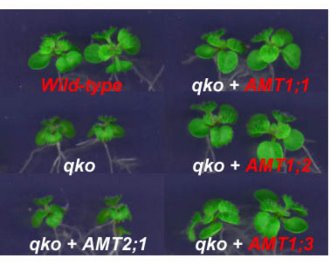Nov. 22, 2007 Research Highlight Biology
Soaking up ammonium
The uptake and transport of ammonium in plants depends on a small set of highly specialized genes
 Figure 1: A comparison of wild-type plants and quadruple mutants (qko) in which four ammonium transporter genes were inhibited. The qko mutant plants had a tenth of the ammonium uptake capacity and half the shoot biomass of the wild-type plants when grown with ammonium. The growth of qko was recovered by restoring the genes AMT1;1, AMT1;2 or AMT1;3. © Takahashi and von Wirén 2007
Figure 1: A comparison of wild-type plants and quadruple mutants (qko) in which four ammonium transporter genes were inhibited. The qko mutant plants had a tenth of the ammonium uptake capacity and half the shoot biomass of the wild-type plants when grown with ammonium. The growth of qko was recovered by restoring the genes AMT1;1, AMT1;2 or AMT1;3. © Takahashi and von Wirén 2007
Nutrients, water and other essentials are delivered into plant cells by special genetic proteins known as membrane transporters. For example, several membrane transporter genes have been identified in thale cress, Arabidopsis thaliana, which affect the transport of ammonium—an important source of nitrogen that assists plant growth and crop-yield quality.
Now, according to work undertaken at the RIKEN Plant Science Center in Yokohama, in collaboration with a team led by Nicolaus von Wirén from the University of Hohenheim in Germany1, it seems that the ammonium transporter genes in Arabidopsis have highly specialized roles in different parts of the plant.
The researchers disrupted four out of the six ammonium transporters in Arabidopsis to create the first quadruple mutant plant—then they restored the transporters one at a time to determine their individual roles.
The quadruple mutant plants lost 90 to 95% of their ammonium uptake capacity. When they were exposed to ammonium, their shoots only grew to half the size of wild-type plants (Fig. 1). In the presence of nitrate (the other form of the nitrogen source) there were no differences in shoot size—implying the importance of the so-called ‘high-affinity ammonium uptake system’ in intake of ammonium. Restoring the genes AMT1;1, AMT1;2 or AMT1;3, but not AMT2;1, recovered the growth of the quadruple mutant (Fig. 1).
“The high-affinity system can facilitate the uptake of low concentrations of ammonium,” says RIKEN scientist Hideki Takahashi. “Therefore, the system is particularly important when supply of ammonium is limited—the usual situation in soil.”
The researchers found that a fifth transporter gene called AMT1;5 was activated in the quadruple mutant. AMT1;5 appears to act alongside two of the other ammonium transporter genes, AMT1;1 and AMT1;3, in the outermost cells of the root tips and in the root hairs—where ammonium first enters the plant directly from the soil. On the other hand, AMT1;2 works in inner cells called the ‘endodermis’.
The research is not only relevant to Arabidopsis. “Rice and poplar have similar ammonium transporters,” says Takahashi, “and the transporters are also likely to be similar in other crops, grasses and trees.”
Takahashi believes that, given this new genetic knowledge, we could eventually produce plants that use nitrogen more efficiently, thereby reducing the need for artificial ammonium fertilizer. He explains: “We may need to manipulate both the expression levels and transport capacities of ammonium transporters to acquire such useful traits.”
References
- 1. Yuan, L., Loqué, D., Kojima, S., Rauch, S., Ishiyama, K., Inoue, E., Takahashi, H. & von Wirén, N. The organization of high-affinity ammonium uptake in Arabidopsis roots depends on the spatial arrangement and biochemical properties of AMT1-type transporters. The Plant Cell 19, 2636–2652 (2007). doi: 10.1105/tpc.107.052134
